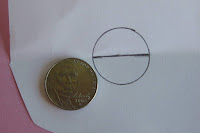This is a plate that I decorated for S2G's April in Paris Blog Hop. I had so many comments on this plate! Today I'm going to show you how to make your very own.
Here's what you'll need: a clear glass plate, rubbing alcohol, clear nail polish, paper towels, a craft stick, pencil, plain white copy paper, a nickel, markers (I used Copics and Bic.), Vitrea Frosted markers ( I used Orange and Mint.), and one package Grafix Rub-Onz Paper.
Wash the glass plate with soap and water. Rinse and dry. Wipe the plate with rubbing alcohol and a paper towel. Dry and set aside. Cut a section of white copy paper and trace around a nickel. Draw a line through the center of the circle.
Place a dot to the left of the circle to use as a guide for placement of the scallops. Turn the plate face down. Position the circle near the edge of the plate and trace that portion of the plate's rim.
Now you have a paper guide that you can move around the plate and be able to make all of the scallops the same size at an equal distance apart. As you paint around the plate, and see that you are near the end, you can adjust the distance closer or farther apart. If you make a mistake, the paint can be removed with rubbing alcohol or nail polish remover.
After your scallops are complete, go back and draw a small dot at each end.
Now draw a dot in the center of each scallop and in between each one. Allow to dry for 24 hours. Set the plate on a cookie sheet and place in a cold oven. Preheat to 170 degrees, and then bake for 35 minutes. Allow the oven to cool for at least an hour after baking before opening the door. I cracked the oven open a few inches and allowed the plate an additional 20 minutes to cool before removing it.
When completely cool, wipe the bottom center of the plate with a paper towel slightly moistened with alcohol. Set aside.
This part of the project is NOT dishwasher safe.
Choose your digital image and drop into a Word Program. I used S2G's "Tres Francais". Use the ruler guide at the top to choose an approximate size that will fit on your plate. Place it in the corner of the screen to conserve paper when printing.
Print the image out on copy paper and measure it against the plate. Adjust the size if needed. When the digital image is the correct size, you are ready to print it on the Grafix paper. The package contains two types of paper: Transfer Film- one side matte or frosted, one side shiny, and Adhesive Film- one side glossy and one side white liner.
Print your image on the Transfer Film; matte side. Now you are ready to color your image. Color small sections with the Copic blender and while still wet apply color on top. Don't press too hard or go over the image too many times, or your paper will tear. How do I know that? LOL
Cut a piece of the Grafix Adhesive Film that is slightly smaller than the Transfer Film that your image was printed on.
Slowly peel the Adhesive Film away from the white liner. Discard liner.
Carefully place film, sticky side down, on top of the image. Holding the film in one hand, I start at the bottom and carefully smooth the film, working my way to the top.
Rub the craft stick in a circular motion over the digital image, forcing out any air bubbles, and ensuring that the film sticks well to the image.
Turn the craft stick on its side, and press firmly sliding to the outer edges. Work from the center outwards, and you should be able to remove any remaining air bubbles.
Cut the digital image out leaving a very small border around the outer edges.
When cut out, turn the craft stick on its side again, and carefully rub over the image again.
Turn the plate face down, and position the images where they look best.
Remove the clear film from the images. Discard film.
Carefully place images on back side of plate, sticky side down. The white backing is still attached. Rub again in a circular motion securing the image to the plate. As you rub, the white backing will begin to loosen.
When decal is firmly attached, the white backing will seperate and can then be discarded. Do not rush this process. If it won't lift off easily, it needs more rubbing.
One last chance, if the digi needs touching up, now is the time!
Give the digi two coats of clear nail polish. Try not to paint too far outside the edges of the image.
Now you have a gorgeous plate that you made yourself! When it's finished, don't look for flaws. Chances are no one will notice any unless you point them out. Besides, it's handmade. That's part of its beauty!
Display and enjoy!

























No comments:
Post a Comment
Thanks for stopping by! I appreciate your comments!